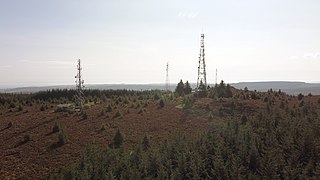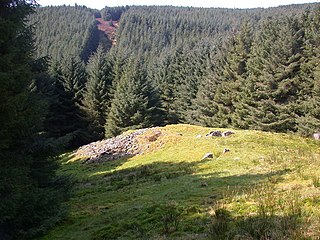
Memsie Cairn is an ancient cairn in Memsie, near Fraserburgh, Aberdeenshire, Scotland.
Historic Scotland believe the burial cairn to be from the Bronze Age. It is an ancient historic monument managed by Historic Scotland. [1]

Memsie Cairn is an ancient cairn in Memsie, near Fraserburgh, Aberdeenshire, Scotland.
Historic Scotland believe the burial cairn to be from the Bronze Age. It is an ancient historic monument managed by Historic Scotland. [1]

The Clava cairn is a type of Bronze Age circular chamber tomb cairn, named after the group of three cairns at Balnuaran of Clava, to the east of Inverness in Scotland. There are about 50 cairns of this type in an area round about Inverness. They fall into two sub-types, one typically consisting of a corbelled passage grave with a single burial chamber linked to the entrance by a short passage and covered with a cairn of stones, with the entrances oriented south west towards midwinter sunset. In the other sub-type an annular ring cairn encloses an apparently unroofed area with no formal means of access from the outside. In both sub-types a stone circle surrounds the whole tomb and a kerb often runs around the cairn. The heights of the standing stones vary in height so that the tallest fringe the entrance and the shortest are directly opposite it.

Kilmartin Glen is an area in Argyll north of Knapdale. It has the most important concentration of Neolithic and Bronze Age remains in mainland Scotland. The glen is located between Oban and Lochgilphead, surrounding the village of Kilmartin. In the village, Kilmartin Museum explains the stories of this ancient landscape and the people who dwelt there. There are more than 800 ancient monuments within a six-mile (ten-kilometre) radius of the village, with 150 monuments being prehistoric. Monuments include standing stones, a henge monument, numerous cists, and a "linear cemetery" comprising five burial cairns. Several of these, as well as many natural rocks, are decorated with cup and ring marks.

Cairn O' Mounth/Cairn O' Mount is a high mountain pass in Aberdeenshire, Scotland. The place name is a survival of the ancient name for what are now the Grampian Mountains, earlier called "the Mounth". The name change happened from circa 1520 AD. The Ordnance Survey shows the name as Cairn o' Mount.

Bedd Taliesin is the legendary grave (bedd) of the poet Taliesin, located in Ceredigion, Wales. The Bronze Age round cairn is a listed Historic Monument. It is a round-kerb cairn with a cist about 2m long. The capstone has fallen; the side stone slabs are more or less in their original positions.

Càrn Liath is an Iron Age broch on the eastern shore of the Scottish Highlands, near Golspie, Sutherland.

Ballymeanoch is a complex of neolithic structures located in Kilmartin Glen, Scotland.

Fetterangus is a small village in Aberdeenshire, Scotland, located just to the north of Mintlaw. Fetterangus is often called "Fishie", though the origin of this nickname is unknown.

Durris Forest is a chiefly coniferous forest south of the River Dee approximately three kilometres west of Netherley in Aberdeenshire, Scotland. The A957 road forms the southwest boundary of Durris Forest, separating it from Fetteresso Forest. The Durris Forest includes several smaller named woodlands. The ancient route of Elsick Mounth crosses the Grampian Mounth within the Durris Forest. Notable natural features in the vicinity include Red Moss and Meikle Carewe Hill. Notable historic features in this area include Raedykes Roman Camp, Muchalls Castle and Maryculter House.

Castle Bloody is a prehistoric feature on the island of Shapinsay, Orkney, Scotland. Hogan observes that while the feature is marked as a chambered mound on the UK Ordnance Survey map, the structure is more properly and specifically classified as a souterrain or earth house. Slightly to the north is located the ruined historic Linton Chapel.

Auld Bourtreebush is a large Neolithic stone circle near Portlethen in Aberdeenshire, Scotland. It is also known as Old Bourtree Bush or Old Bourtreebush. This megalithic construction is situated near the Aquhorthies recumbent stone circle and the Causey Mounth, an ancient trackway which connects the Scottish Lowlands to the highlands. It is a scheduled monument.

Cairn Mon Earn or Cairn-mon-earn is a hill in Aberdeenshire, Scotland.

Barpa Langass, is a Neolithic chambered cairn on the Isle of North Uist in the Outer Hebrides of Scotland. It measures about 72 feet in diameter by 18 feet in height, and is around 5,000 years old. The roof is constructed of two massive slabs with a third slab superimposed.
Memsie, Aberdeenshire, is a small community near Fraserburgh, Scotland. On Memsie Moor there is a very large stone cairn, Memsie Cairn, which has been opened, but nothing found inside. There were two other cairns, but they have been removed. Apart from the cairn, Memsie is near Mormond Hill, which was a very large listening post in the Cold War. These days the former listening post is used for satellite communications. The nearest Kirk to Memsie is in Rathen.

Midhowe Broch is an iron-age broch located on the west coast of the island of Rousay in the Orkney Islands, in Scotland.

Sunhoney is a stone circle of the recumbent type, which is common in the Grampian region, in particular at the River Dee. Sunhoney is situated about 2 km west of Echt in Aberdeenshire, near to the Cullerlie and Midmar stone circles. It is designated a scheduled ancient monument

Culduthel is an area in the south of the city of Inverness, in the Highland council area of Scotland. The area is largely residential, and is the location of Inverness Royal Academy.

Carn Ban is a Neolithic chambered tomb located on the Isle of Arran in Scotland.

There are fourteen stone cairns on the Balmoral estate in Deeside, Scotland, including a single cairn on the adjoining Birkhall estate. The cairns commemorate members of the British royal family and events in their lives. The majority of the cairns were erected by Queen Victoria.

Loanhead of Daviot stone circle is a recumbent stone circle in Aberdeenshire in lowland northeast Scotland. The circle consists of the recumbent stone with its flankers and a complete set of eight orthostats about 21 metres (69 ft) in diameter surrounding a low kerbed ring cairn which has an open court. However, the present appearance has in part been produced by substantial restoration after archaeological excavation in 1934, and in 1989 by the removal of the stones covering the central court.

House of Memsie is a Category A listed country house and estate in Memsie, Aberdeenshire, Scotland. It dates to around 1760, and it received its historic designation in 1971. It was formerly the home of the Fraser family for over three hundred years. It was sold to Lord Saltoun in the early 19th century. A Captain Dalrymple was another previous owner. Historian Charles McKean describes it as a "smaller and more decorative version of Aberdour House".
Coordinates: 57°38′54″N2°02′27″W / 57.6483°N 2.0409°W